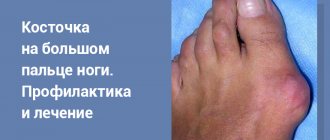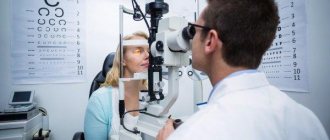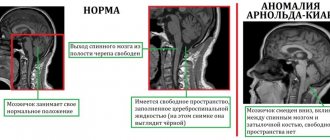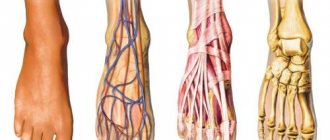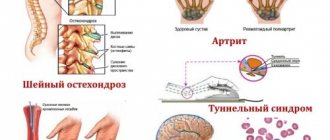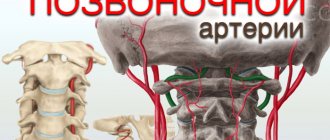Causes
In medical practice, burning and tingling in the legs is called paresthesia. There are many factors that cause discomfort in the legs. Experts divide them into physiological and pathological, i.e. associated with diseases of bones, muscles, joints and internal organs.
Reference ! In order to understand why your toes are burning, you should consult a therapist. Attempts at self-medication can lead to serious consequences, including disability.
Lesions of the musculoskeletal system
The group of factors that cause discomfort in the legs includes the following reasons:
- injuries of the lower extremities: dislocations, soft tissue bruises, open wounds on the legs, bone fractures, muscle sprains, ligament tears, etc.;
- chronic inflammatory diseases of the joints - arthritis of any etiology (viral, bacterial, gouty, nephrotic, etc.);
- degenerative changes in joints in the form of arthrosis;
- congenital pathologies of bones, muscles or joints;
- spinal deformity: pathological kyphosis, scoliosis;
- growth of tumors in the skeletal system;
- purulent osteomyelitis, etc.
In addition, heat in the lower extremities can develop against the background of osteochondrosis, accompanied by damage to the nerve roots or peripheral nerves. In this case, patients complain that a hot wave passes through the leg and a “shooting” pain occurs.
Other reasons
The physiological conditions in which discomfort in the legs develop are different. The most common reasons are:
- prolonged static position of the limb, which can cause compression of the nerve endings. For example, paresthesia appears in the morning after sleep or during prolonged sitting in a cross-legged position;
- wearing uncomfortable, tight shoes;
- long stay in the cold;
- pregnancy, excess body weight, etc.
These circumstances do not require medical attention or treatment. During rest, discomfort in the lower extremities completely disappears. In addition to diseases of the musculoskeletal system, the causes of heat in the legs can be diseases of other body systems:
- metabolic disorders. With diabetes, the soles of your feet become hot, and with gout, your big toe burns;
- atherosclerosis of the arteries of the lower extremities;
- fungal infection of toenails. Paresthesia is accompanied by itching of the fingers and clouding of the nail plate;
- obliterating endarteritis of the lower extremities;
- allergic reaction to fabrics and materials from which shoes are made;
- varicose veins;
- thrombophlebitis - patients complain that the inside of the leg is burning.
A number of factors predispose to the development of pathology: smoking, sedentary lifestyle, obesity, poor nutrition or following a low-protein diet.
What disease causes burning feet?
The reasons why a burning sensation occurs in the feet are quite varied.
Allergic reaction
An allergic reaction to the materials from which clothing or shoes are made. Synthetics, dyes, and additives for treating shoes can cause severe irritation of the skin of the feet, which is manifested, among other things, by severe burning.
Treatment in this situation consists of replacing allergenic clothing or shoes and using local antihistamines.
Fungus
Mycosis . Fungal infection of the skin of the feet is manifested by severe itching and burning on the feet, between the toes. The skin in these places becomes rough, peels, and cracks.
If the foot of only the left leg or only the right one burns, it is likely that we are talking about a fungal infection. To eliminate unpleasant symptoms, you need to get rid of the fungus.
Diagnostic measures
The initial examination by a specialist includes the collection of complaints and anamnesis of the disease, since it is important for the doctor to find out at what time the symptoms develop, what precedes them, and how long these sensations have been haunting the patient. An examination of the lower extremities is also carried out, assessing the color and temperature of the skin, the level of hair growth and skin condition. With atherosclerosis or obliterating endarteritis, ulcerative defects in the ankle area, as well as increased keratinization of the epidermis, can be detected.
Additional methods to help clarify the clinical diagnosis:
- laboratory diagnostics allows you to find signs of inflammation and metabolic disorders (clinical and biochemical blood tests, general urine analysis);
- X-ray examination of the pelvis and legs (confirming or refuting the presence of a fracture);
- ultrasound diagnostics of the joints of the lower extremities (assessment of the condition of the joint elements), including ultrasound with Doppler of the veins of the lower extremities (the level of blood flow in the legs is examined);
- computed tomography or magnetic resonance imaging with or without contrast in severe diagnostic cases.
Correct diagnosis and identification of the causes of discomfort allow you to select effective therapy.
Treatment methods for Gopalan syndrome
The causes and treatment of Gopalan syndrome include a wide range of options, since discomfort in the legs can be a symptom of an impressive number of ailments. Including being a common allergic reaction to wearing synthetics. Therefore, starting any treatment is permissible only after an accurate diagnosis and identification of the factor that caused Gopalan syndrome of the disease. This is very important, since drug treatment of some types of diseases can cause noticeable harm to the body or provoke a relapse of a number of systemic diseases.
If the patient's feet are very bothersome due to a simple allergic reaction to artificial materials in clothing or shoes, the use of therapeutic antihistamines is often sufficient for treatment. For more serious pathologies, a different approach is required, since the prescribed drug complex should be carefully compared with the treatment of the disease that caused the uncomfortable burning sensation. Medicines widely use such means as:
- antimycotic drugs for the treatment of fungal diseases;
- B vitamins to eliminate B-vitaminosis;
- antioxidants and antidepressants as anticonvulsants;
- tricyclic antidepressants as a remedy for peripheral neuropathy;
- biguanides, meglitinides, sulfonylureas and alpha-glucosidase inhibitors are agents that help in the treatment of Gopalan syndrome in patients with diabetes mellitus;
- anticoagulants when the burning sensation is caused by thrombophlebitis;
- drugs for the treatment of gout and glucocorticosteroids;
- venotonics, antihypoxants, capillary-stabilizing agents to stop the progress of varicose veins.
Self-treatment of serious diseases without a preliminary diagnosis from an experienced specialist most often ends in the aggravation of degenerative processes occurring in the body. Often added to this is the appearance of drug-induced damage to the mucous membrane of the stomach and liver due to uncontrolled use of medications. Remember, there are many reasons why feet burn. And many of them, without an accurate diagnosis and the right course of treatment, pose a serious threat to health.
Which specialist should I contact?
A burning sensation not associated with disease occurs very rarely and usually goes away in a short period of time. Patients ask doctors about what to do if their feet hurt and burn often, up to several times a day. If symptoms appear repeatedly, do not disappear with rest, and progress, you should immediately seek medical help. The warning signs are as follows:
- change in skin color;
- development of swelling or numbness;
- the appearance of microcracks or ulcers for no apparent reason;
- erosions on the feet;
- rash on legs and itching;
- burning sensation in the upper part of the foot and pain.
First, you can visit your local physician at the clinic, he will conduct an examination and, if necessary, refer the patient to another specialist. In addition, the patient can contact a phlebologist, vascular surgeon, rheumatologist, traumatologist or orthopedist directly.
Relatives of some patients are interested in what to do if the legs of an elderly person are on fire. In this case, experts advise contacting an endocrinologist or vascular surgeon, since the pathology is more often associated with diabetes mellitus or atherosclerosis of the arteries of the lower extremities.
Attention ! At your appointment, your doctor will use additional diagnostic methods to help you find out why your legs are burning before bed or why your feet are burning after walking or other physical activity.
First aid using traditional medicine
Burning sensations in the legs are no joke, and it is necessary to relieve the problematic symptom in time or consult a doctor. Fortunately, depending on what's causing the burning, there are some first aid steps you can take at home:
- Turmeric . Will help get rid of burning feet. Turmeric is said to help improve blood flow and circulation and can also help clear up inflammation. You can use it as a paste (mix it with water) or drink it (again, mix it with water or as a tea).
- Cold water. This is the easiest way. Soaking your feet in cold water can potentially relieve the burning sensation, especially if the pain is caused by standing on your feet too much. Just take out a bowl, fill it with cold water and lower your feet. This remedy will also help when there is a muscle problem or injury. It is important to know that if your feet are burning due to erythromelalgia, then cold water can cause heat in your feet.
- Hot or warm water. Just like cold water foot baths, hot or warm water can also relieve the burning sensation, but in a different way. Warm water can help improve blood circulation and relax your leg muscles. This method is best for burning feet caused by injury, muscle tension, excessive alcohol consumption and circulatory problems.
- Epsomatic salts. Epsom salts are used to relieve back and other muscle pain, so there's a good chance it will help your feet, too. Take a bath of warm water and pour half a cup of Epsom salts into it. Soak your feet for 15-20 minutes.
- Thyme. The herb can provide relief by promoting circulation and loosening constricted blood vessels. It can also help "athlete's foot." Take a handful of thyme and soak it. Fill two foot containers: one with hot water and one with cold water. Add the infused thyme along with the water to each container, divided evenly. Soak your feet in a hot water bath for about 3-5 minutes, and then move to a cold water bath for a few minutes. Continue this alternation for about 20 minutes.
- Vitamin B3. Vitamin B3 helps with blood circulation and strengthens the nerves, which is essential when your feet are burning. You can simply add more vitamin B3 to your diet by consuming wheat bran, wheat germ, whole grain products, brewer's yeast, green vegetables, beans, peas, milk, yogurt, peanuts and egg yolks.
- Massage. Foot massage can alleviate the condition if it is not associated with diseases of the skin of the feet. You can remove the burning sensation by kneading and rubbing your foot, starting from the toes and gradually moving towards the heel. Then you need to lightly pull each finger. Also use homemade remedies: pour coarse cereal into the bath, pebbles or small stones will also work, and walk on them.
- Apple vinegar. There are several ways to use apple cider vinegar. You can either drink it by taking two tablespoons of apple cider vinegar and mix it with a glass of warm water (once a day) or add two tablespoons to any of the above mentioned foot baths.
- Cold and hot shower. Take a contrast shower more often; you can simply pour cool and warm water on your feet alternately. Do not use water that is too hot or too cold. Repeat dousing for about 20 minutes. After the procedure, lubricate your feet with any cooling cream that contains menthol.
- Raising your legs above head level. This procedure will improve blood flow. Raise your legs above head level and lie down for at least 15 minutes. Lubricate your feet with cream similar to the previous method.
- Herbal baths . This is an excellent calming procedure. For baths, use chamomile, wormwood, calendula, hops, linden blossom and other herbs. First you need to prepare a decoction in the proportion of 2 tablespoons per 1 liter of boiling water. Pour into the bath, wait for a comfortable temperature and relax your feet for 20 minutes.
- Essential oils. A combination of rosemary, pine and lavender oils will help relieve the condition. Rosemary oil stimulates and improves blood circulation. Pine oil has a refreshing, disinfectant and deodorizing effect, while lavender oil has a relaxing and soothing effect and helps cool the feet.
Elimination of disease
The causes and treatment of burning in the feet are closely related, since therapy should be aimed at eliminating the main causative factor. After examining the patient, the attending physician selects a treatment regimen and rehabilitation plan. They depend on the pathology that caused the burning sensation in the legs. Typically, etiological therapy (treatment of the immediate cause of the disease), symptomatic remedies, and in cases of severe pathologies, surgical interventions are prescribed. Additionally, traditional medicine can be used with the permission of a specialist. Therapy should always be comprehensive and aimed at improving the patient’s quality of life.
Symptomatic remedies
Medicines are selected individually for each cause:
- allergic lesions of the feet - desensitizing drugs “Loratadine”, “Cetrin”;
- vascular lesions - non-steroidal anti-inflammatory drugs “Nise”, “Ketorol”, “Ibuprofen”;
- venotonic drugs (“Venarus”, “Detralex”) and angioprotectors (“Rutin”, “Tocopherol”) for varicose veins.
Infections are treated exclusively with antibacterial drugs (“Amoxiclav”, “Azithromycin”), antiviral or antifungal drugs (“Clotrimazole”, etc.), depending on the identified pathogen
Folk remedies
Identifying the reason why your feet are hot at night allows you to select alternative medicine methods. They can only be used as an addition to the main treatment. It is not allowed to use traditional recipes as the only method of therapy - this can lead to negative consequences, the spread of infection throughout the body, etc.
Alternative treatment approaches to eliminate discomfort in the lower extremities:
- overnight compress made from sour milk and crushed wormwood herb . Both components are mixed, placed on a napkin and applied to the burning area. The product helps reduce inflammation and discomfort;
- infusion of nettle leaves - 300 g of plant leaves are crushed, poured with boiling water and infused for 30-40 minutes. The resulting infusion is cooled and divided into three parts, and 75 ml is taken before meals. The course of treatment is 4-6 months;
- compress of crushed garlic and 2 teaspoons of olive oil. The mass is applied to the sore spot, covered with a bandage and secured with a bandage. Most often, this procedure is carried out before bedtime. In the morning, wash off the composition with warm water.
Attention ! People with allergies, asthma and contact dermatitis should consult an allergist before using plants and recipes based on them.
Drug therapy
Treatment of burning sensation in the feet is primarily aimed at eliminating the root cause that provoked this condition, and involves the use of the following drugs:
We also recommend reading: Acute pain in the foot
- in the case where the diagnosis has confirmed the allergic nature of the burning sensation in the feet, it is recommended to take antihistamines (Suprastin, Diazolin, Loratadine, Zyrtec, etc.);
- for fungal etiology of the disease, antimycotic drugs are prescribed (Terbinafine, Clotrimoxazole, Naftivin, Miconazole, etc.);
- to relieve pain and inflammation, it is recommended to take NSAIDs (Diclofenac, Ortofen, Ibuprofen, etc.);
- for gout, Anturan and Colchicyl are prescribed, as well as corticosteroids (Prednisolone, Hydrocortisone, etc.);
- to normalize venous tone, venotonics are prescribed (Detralex, Aescusan, Venarus, etc.), and if the feet are burning due to thrombophlebitis, it is recommended to take anticoagulants (Heparin, Warfarin, etc.);
- in diabetes mellitus, a burning sensation can be present not only in the feet; similar symptoms can also affect the palms, which requires mandatory treatment, primarily with drugs such as Bucarban and Glyurenorm;
- To compensate for the deficiency of vitamin substances, oral intake of B vitamins (Neurobion, Tienshi, etc.) is recommended.
For burning and painful symptoms, intramuscular and intravenous injections of antispasmodics and painkillers (Analgin, Spazgan, Trigana, etc.) are often given, but the main role in therapy is given to physiotherapy (electrophoresis, paraffin-ozokerite applications, massage, exercise therapy, etc. ).
Prevention methods
A number of recommendations will help prevent discomfort in the legs:
- wearing comfortable shoes;
- compliance with personal hygiene rules. Be sure to use only your own shoes;
- active lifestyle: sports, jogging, swimming in the pool, yoga, tourism, physical therapy, etc.;
- good nutrition: enriching the diet with vegetables and fruits, herbs, lean meat;
- giving up bad habits (smoking, drinking alcohol);
- taking vitamins and microelements;
- using compression stockings when standing for long periods of time at work.
By following this advice, it is possible to significantly reduce the risk of discomfort and burning in the lower extremities.
Natural and artificial stimuli
Regular burning in the feet is often considered as a symptom of a patient’s chronic or acute illness. But this requires diagnostics, which will eliminate the random nature of the occurrence of discomfort. There are options when they, to a certain extent, can be considered the norm, since they are the result of natural biological processes. For example, the feet can often burn in women during pregnancy, as well as in people who are obese. The reason for this is an increase in body weight and, accordingly, the load on the soles of the feet. A similar situation is often observed after a foot injury, of which there are many varieties.
Often, burning sensations are the result of inconsistent or mandatory intake of various medications. They are often observed in patients who are prescribed a course of:
- antiretroviral drugs against HIV;
- drugs for chemotherapy;
- vitamin B6 in case of overdose;
- strong drugs such as isoniazid, amiodarone, metmorphine and others with similar side effects.
The discomfort in question occurs even after an operation that has nothing to do with the legs - gastric bypass. The appearance and development of symptoms can be observed several weeks and even months after the completion of the operation. The cause of discomfort in this case is usually neuropathy, which is provoked by a deterioration in the absorption of B vitamins by the stomach.
Etiology
A burning sensation in the feet can be a consequence of certain diseases that do not always relate specifically to the musculoskeletal system, or it can be a manifestation of the negative impact of external etiological factors on the lower extremities.
Ailments whose clinical picture includes burning of the feet include:
Regarding external etiological factors, which can also lead to a burning sensation in the foot when walking or at rest, the following should be highlighted:
- wearing uncomfortable, narrow or poorly breathable shoes;
- lack of personal hygiene;
- excessive sweating of the feet;
- excess weight, which leads to unjustified physical stress on the musculoskeletal system;
- prolonged static loads, excessive walking;
- physical or psychological fatigue.
Separately, it should be said that burning in the feet can be observed during the third trimester of pregnancy, which in itself is not a manifestation of a specific ailment, but a consultation with a doctor will not be superfluous.


